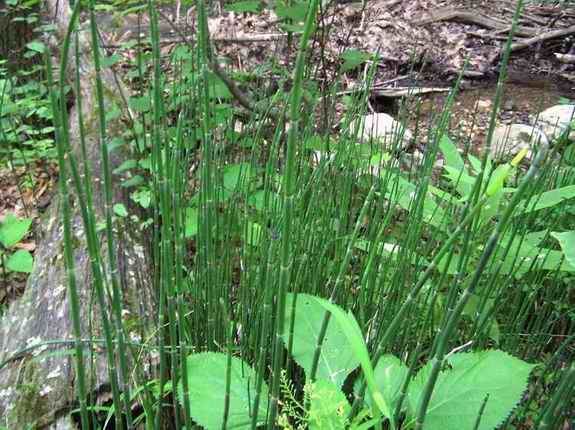|
Return to Hiker's Notebook Home Page
Common Name: Horsetail, Scouring rush, Dutch rush, Pewterwort, Shave grass, Bottle brush, Corn horsetail. Corncob plant, Horse willow - The side branches on some species extend from the center bare stalk in a manner that suggests a horse's tail.
Scientific Name: Equisetum spp- The generic name is a combination of the Latin words equus meaning horse and saeta meaning bristle. The field or common horsetail is E. Arvense; the Latin word arvum means ploughed land, or, more generally, field. The greater horsetail is E. hyemale, meaning "of the winter" as it persists in winter; it is larger than the common horsetail and does not have side branches (pictured above).
The horsetails are the only survivors of the once large Sphenopsida Class which proliferated in the primeval forests of the Carboniferous period of the Paleozoic era, contributing to the massive coal beds that were formed about 300 million years ago. Some of the segmented plants of the class were the size of trees; the most notable were the plants of the genus Calamites whose ubiquity is registered in the fossil record. Equisetum is thus one of the oldest genera among extant flora; it is the only member of the family Equisetaceae which is the only member of the order Equisetales. There are 15 living species of horsetails on every continent except Australia and Antarctica.
The field and greater horsetails are perennial vascular plants that propagate with spores while expanding via a vegetative rhizomorphous root structure, an arrangement that is likely the reason for the survival of the genus through the mass extinctions that mark the terminal points of the geologic eras. The aerial stems emerge from the subterranean rhizome according to fecundity; the fertile, spore bearing shoots emerging first and wilting in advance of the sterile, bamboo-like rushes that persist to form the characteristic copse. The fertile stem terminates in a conical strobilus, which is comprised of sporangiophores that hold the spore-bearing organs. Four coiled bands called elaters are attached to each spore; they uncoil in response to humidity conditions to ensure that the spore is ejected into a favorable environment. Germinating asexual spores generally grow into hermaphroditic gametophytes that produce eggs in an archegonium and sperm in an antheridium; their sexual union in a zygote completes the cycle. Like the ferns, the movement of the sperm to the egg requires moisture and is evidence of the horsetail's aquatic origin to evolve as one of the first terrestrial species.
The horsetail has a preponderance of alternative colloquial names that are suggestive of abrasion. The stems are hollow with a vascular system of xylem and phloem on the inner wall to carry out the photosynthetic process. The rigid outer wall that provides mechanical support is composed of sclerenchymatous fibers that are impregnated with silica. The stem of the horsetail was thus a natural abrasive and was used to that effect in Europe and in Colonial North America. The Scouring rush was used for scrubbing pots, taking advantage of the abrasive embedded silica; Dutch rush is indicative of the import of E. hyemale to England from Holland for that purpose. Its effectiveness as a polishing agent is reflected in the name Pewterwort, as it was used to induce the dull sheen of pewter cooking utensils. It was also employed by fletchers (arrow makers) and comb makers to polish their work and by dairymaids to scour milk pails. The horsetail is noted for its selective accumulation of other metallic elements, notably gold and potassium. Silicon and potassium-rich horsetails are indicator plants for these minerals, which is important in the prediction of areas of substrate instability susceptible to landslides.
Horsetails were used as diuretics in Ancient Greece and the culturally descendent Roman empire, a traditional medicinal application that carried over to Europe in general. A poultice made from the dried and ground stems was applied as a vulnerary and an astringent under the name of Cauda equina. According to the noted English herbalist Nicholas Culpepper "It is very powerful to stop bleeding � It also heals inward ulcers � It solders together the tops of green wounds and cures all rupture in children." Native Americans also knew the diuretic properties of horsetail; they employed it more generally in the treatment of kidney disorders and constipation. The farrago of folk remedies that included frostbite, hair loss, gout, itchiness, malaria, and brittle fingernails suggests that the horsetail was considered something of a panacea.
Horsetail is still in use as a medicinal. The German Commission E expert panel approved of the use of horsetail for diuresis based on scientific evidence that it increases the flow of urine. The panel also noted that the high levels of silica in the horsetail may be beneficial in strengthening bones to treat osteoporosis, though this has not been scientifically established. Concerns have been raised that horsetail consumption in large quantities may cause thiamine vitamin deficiencies. It's consumption is generally considered questionable for humans and toxic for animals; Linnaeus reported that cows who fed on horsetail lost their teeth and contracted acute diarrhea. |
